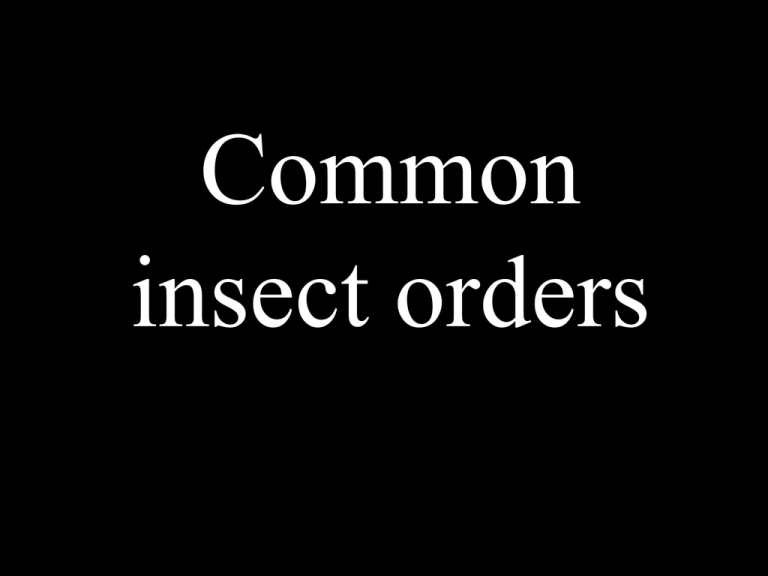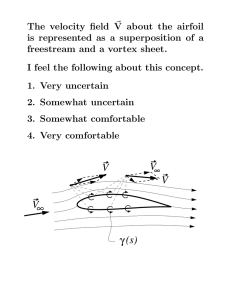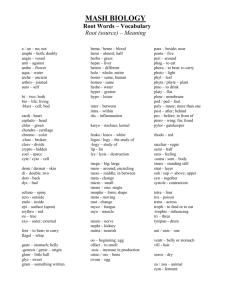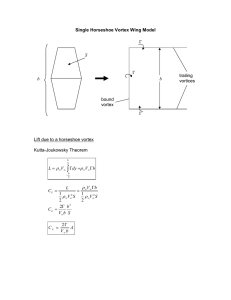Common insect orders
advertisement

Common insect orders Insects are the most speciesrich group of organisms on earth as indicated in this species-scape. The size of the organism reflects the number of described species. Parts of an insect Parts of an insect Head Thorax Abdomen Parts of an insect Head Thorax 3 pairs of legs Abdomen Parts of an insect Head Thorax Abdomen Wings and legs on thorax 3 pairs of legs Important areas to study to identify common insect orders Head Thorax 3 pairs of legs Abdomen Mouthparts: Chewing mandibles mandibles Mouthparts: Sucking Coiled Piercing Sponging-sucking Odonata (dragonflies, damselflies) Greek “odon” = tooth (referring to teeth on their mandibles) Odonata (dragonflies, damselflies) Odonata (dragonflies, damselflies) Spot ID • Long slender wings Odonata (dragonflies, damselflies) Spot ID • Long slender wings • Long thin body Blattodea (roaches) Latin “blatta” = cockroach Blattodea (roaches) Blattodea (roaches) Spot ID • Flat Blattodea (roaches) Spot ID • Flat • Spiny legs Blattodea (roaches) Spot ID • Flat • Spiny legs • Long antennae Orthoptera (grasshoppers, crickets) Greek “orthos” = straight, “pteros” = wing Orthoptera (grasshoppers, crickets) Orthoptera (grasshoppers, crickets) Spot ID • Jumping hind legs Orthoptera (grasshoppers, crickets) Spot ID • Jumping hind legs • Some with ovipositor at hind end Dermaptera (earwigs) Greek “derma” = skin, “ptero” = wing Dermaptera (earwigs) Greek “derma” = skin, “ptero” = wing Spot ID • Long skin-like hindwings folded under very short forewings Dermaptera (earwigs) Greek “derma” = skin, “ptero” = wing Spot ID • Long skin-like hindwings folded under very short forewings • Pinchers off end of abdomen Hemiptera (bugs, hoppers, aphids, scales, cicadas) Greek “hemisys” = half, “ptero” = wing Hemiptera (bugs, hoppers, aphids, scales, cicadas) Greek “hemisys” = half, “ptero” = wing Spot ID • A beak: piercing-sucking mouthparts Hemiptera (bugs, hoppers, aphids, scales, cicadas) Greek “hemisys” = half, “ptero” = wing Spot ID • A beak: piercing-sucking mouthparts • Forewings covering hindwings – Wing half membrane, half thickened or – Wing all membranous Coleoptera (beetles) Greek “koleos”= sheath, “ptero”= wing Coleoptera (beetles) Coleoptera (beetles) Spot ID • Chewing mouthparts Coleoptera (beetles) Spot ID • Chewing mouthparts • Forewings (elytra) form hard shell covering hindwings Diptera (flies) Latin “di”= two, “ptero”= wing Diptera (flies) Latin “di”= two, “ptero”= wing Diptera (flies) Latin “di”= two, “ptero”= wing Spot ID • Two wings Diptera (flies) Latin “di”= two, “ptero”= wing Spot ID • Two wings – Hind wings reduced to halteres Diptera (flies) Latin “di”= two, “ptero”= wing Spot ID • Two wings – Hind wings reduced to halteres • Sponging-sucking mouthparts – Except mosquitoes and some others that pierce skin Hymenoptera (bees, wasps, ants) Greek “hymen”=membrane, “ptero”=wing or Hymen, the Greek god of marriage because the forewing & hindwings are joined together with small hooks Hooks not shown Hymenoptera (bees, wasps, ants) Hymenoptera (bees, wasps, ants) Spot ID • Chewing mouthparts Hymenoptera (bees, wasps, ants) Spot ID • Chewing mouthparts • Four membranous wings Hymenoptera (bees, wasps, ants) Spot ID • Chewing mouthparts • Four membranous wings • Waist often constricted Hymenoptera (bees, wasps, ants) Spot ID • Chewing mouthparts • Four membranous wings • Waist often constricted • Females with ovipositor or stinger at end of abdomen Lepidoptera (butterflies, moths) Greek “lepido”= scale, “ptero”= wing Lepidoptera (butterflies, moths) Greek “lepido”= scale, “ptero”= wing • Coiling-sucking mouthparts Lepidoptera (butterflies, moths) Greek “lepido”= scale, “ptero”= wing • Coiling-sucking mouthparts • Four wings covered with scales Insects and other Arthropods


